Abstract
The authors determined whether response to cholecystokinin-tetrapeptide (CCK-4) was dose-dependent. Healthy volunteers (n = 36) received double-blind injections of either 9 micrograms, 25 micrograms, or 50 micrograms of CCK-4 and placebo in a randomized sequence of injection. Significant dose-related differences were found for the number of symptoms, sum intensity of symptoms and the time until onset of symptoms, but not for the duration of symptoms. The incidence of panic attacks with CCK-4 was 11%, 17% and 47% for the 9 micrograms, 25 micrograms and 50 micrograms dose, respectively. None of the controls panicked with placebo injections. These results support the notion of a dose-dependent effect of CCK-4-induced panic symptoms. Implications of these findings in the neurobiology of panic attacks are discussed.
Full text
PDF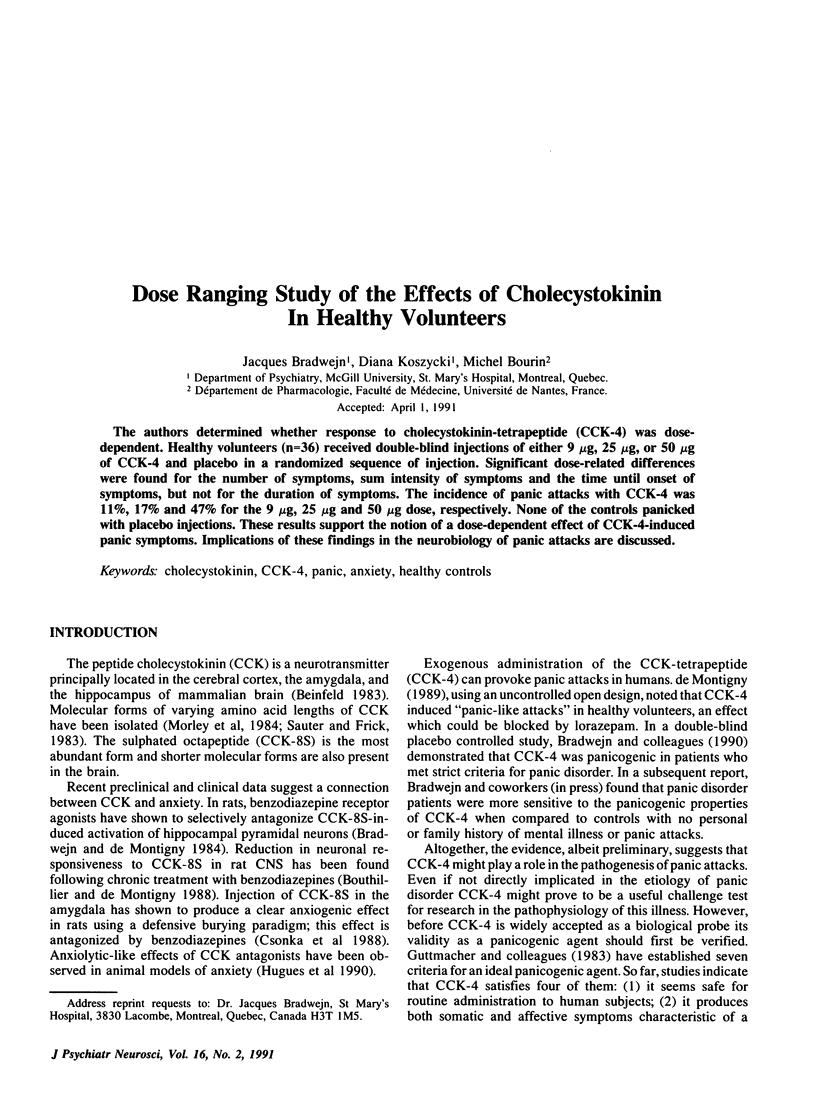
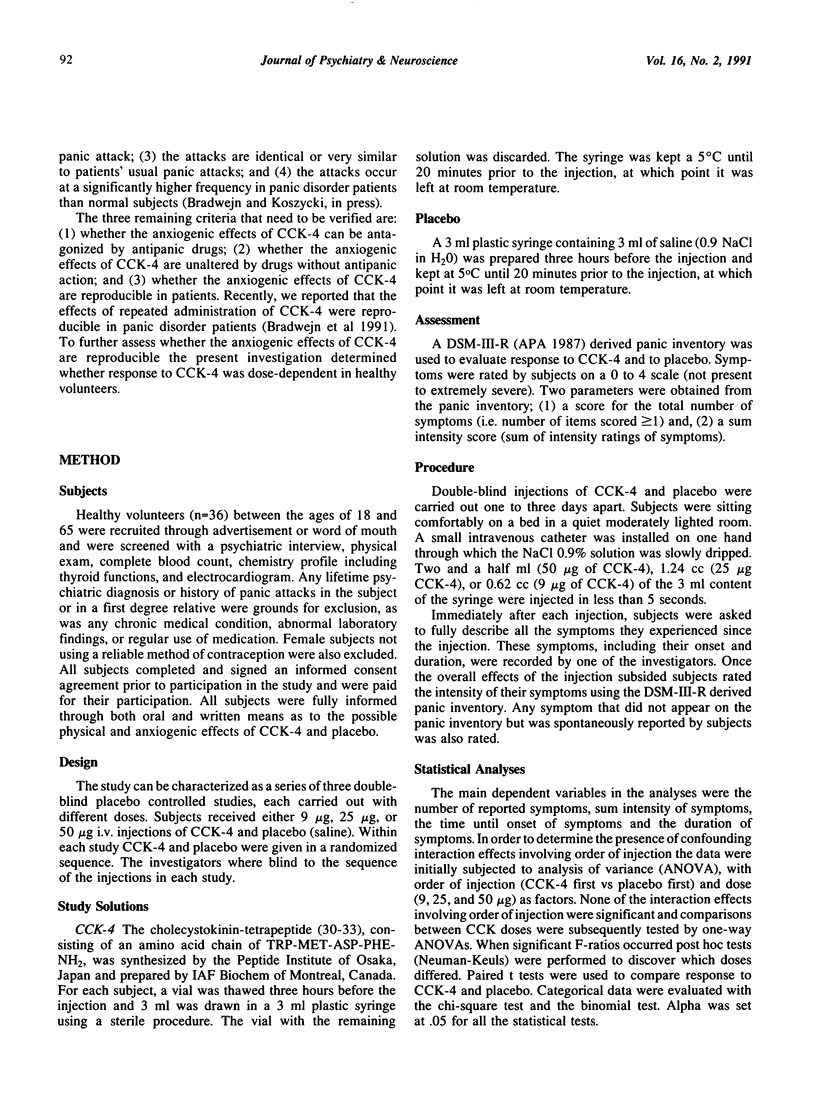
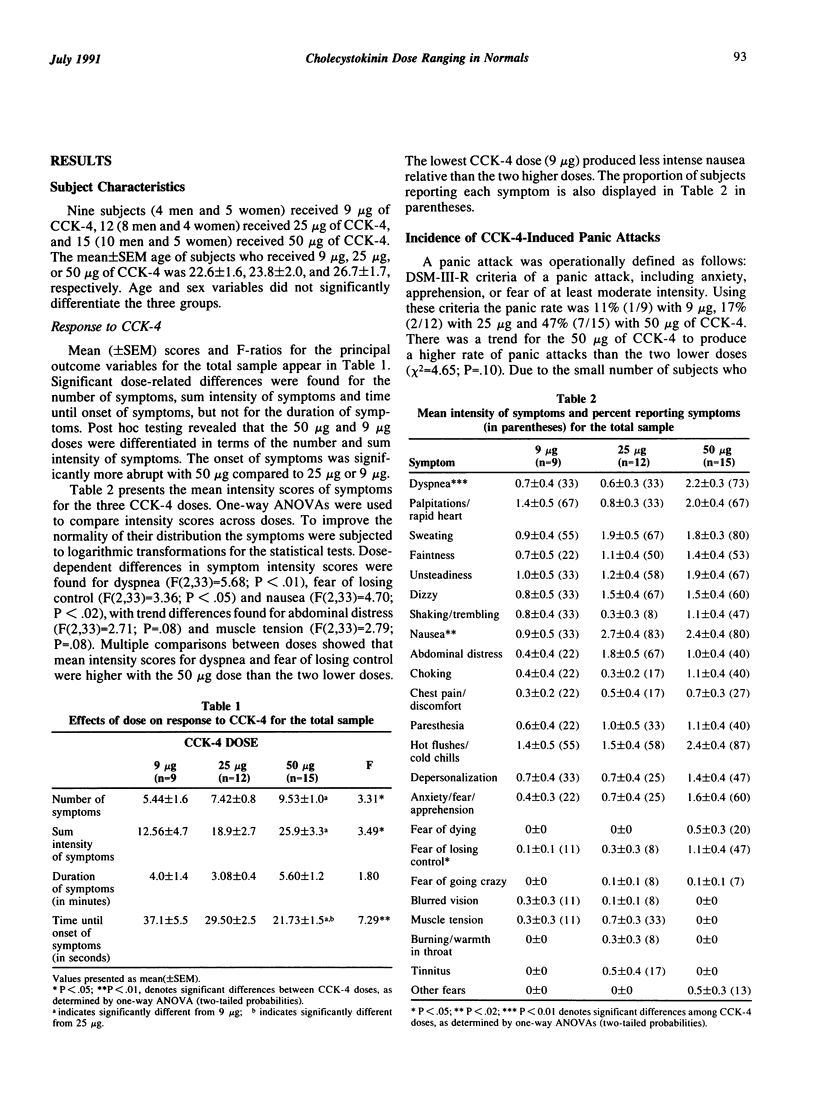
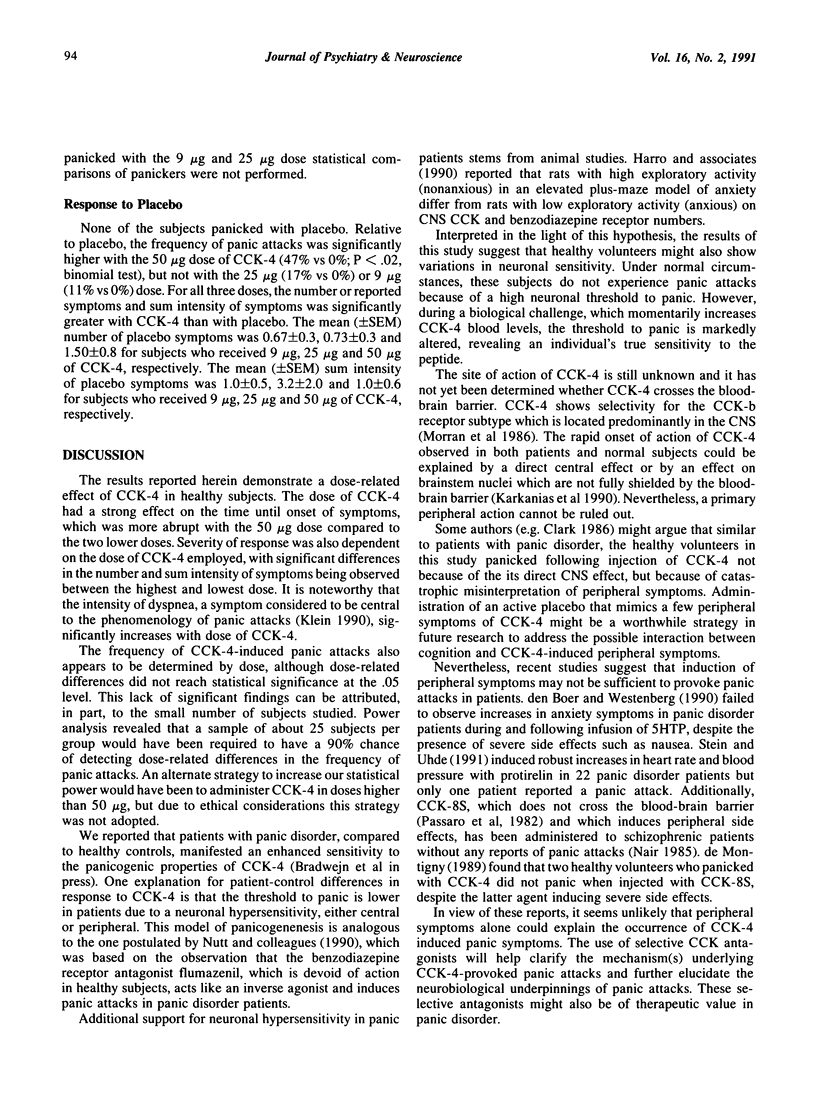
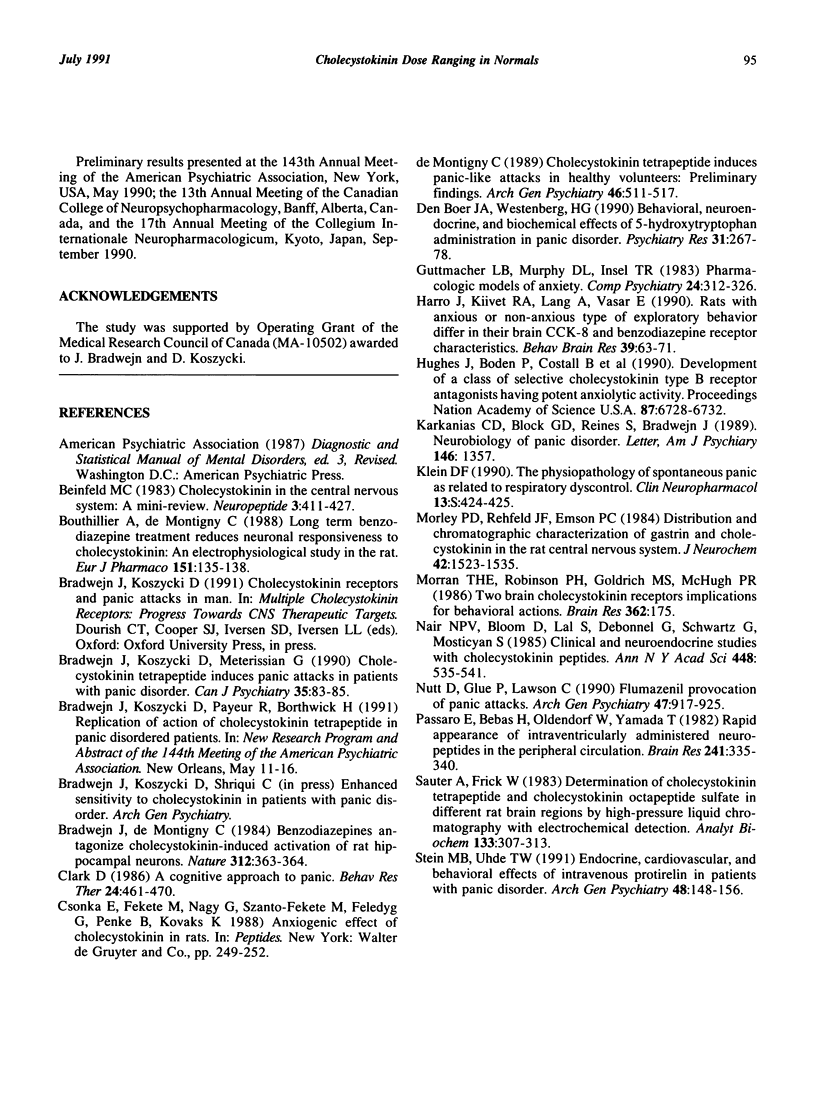
Selected References
These references are in PubMed. This may not be the complete list of references from this article.
- Beinfeld M. C. Cholecystokinin in the central nervous system: a minireview. Neuropeptides. 1983 Oct;3(6):411–427. doi: 10.1016/0143-4179(83)90032-x. [DOI] [PubMed] [Google Scholar]
- Bouthillier A., De Montigny C. Long-term benzodiazepine treatment reduces neuronal responsiveness to cholecystokinin: an electrophysiological study in the rat. Eur J Pharmacol. 1988 Jun 22;151(1):135–138. doi: 10.1016/0014-2999(88)90703-0. [DOI] [PubMed] [Google Scholar]
- Bradwejn J., Koszycki D., Meterissian G. Cholecystokinin-tetrapeptide induces panic attacks in patients with panic disorder. Can J Psychiatry. 1990 Feb;35(1):83–85. doi: 10.1177/070674379003500115. [DOI] [PubMed] [Google Scholar]
- Bradwejn J., de Montigny C. Benzodiazepines antagonize cholecystokinin-induced activation of rat hippocampal neurones. Nature. 1984 Nov 22;312(5992):363–364. doi: 10.1038/312363a0. [DOI] [PubMed] [Google Scholar]
- Clark D. M. A cognitive approach to panic. Behav Res Ther. 1986;24(4):461–470. doi: 10.1016/0005-7967(86)90011-2. [DOI] [PubMed] [Google Scholar]
- Guttmacher L. B., Murphy D. L., Insel T. R. Pharmacologic models of anxiety. Compr Psychiatry. 1983 Jul-Aug;24(4):312–326. doi: 10.1016/0010-440x(83)90059-7. [DOI] [PubMed] [Google Scholar]
- Harro J., Kiivet R. A., Lang A., Vasar E. Rats with anxious or non-anxious type of exploratory behaviour differ in their brain CCK-8 and benzodiazepine receptor characteristics. Behav Brain Res. 1990 Jun 18;39(1):63–71. doi: 10.1016/0166-4328(90)90121-t. [DOI] [PubMed] [Google Scholar]
- Hughes J., Boden P., Costall B., Domeney A., Kelly E., Horwell D. C., Hunter J. C., Pinnock R. D., Woodruff G. N. Development of a class of selective cholecystokinin type B receptor antagonists having potent anxiolytic activity. Proc Natl Acad Sci U S A. 1990 Sep;87(17):6728–6732. doi: 10.1073/pnas.87.17.6728. [DOI] [PMC free article] [PubMed] [Google Scholar]
- Karkanias C. D., Block G. A., Reines S., Bradwejn J. Neurobiology of panic disorder. Am J Psychiatry. 1989 Oct;146(10):1357–1357. doi: 10.1176/ajp.146.10.1357b. [DOI] [PubMed] [Google Scholar]
- Marley P. D., Rehfeld J. F., Emson P. C. Distribution and chromatographic characterisation of gastrin and cholecystokinin in the rat central nervous system. J Neurochem. 1984 Jun;42(6):1523–1535. doi: 10.1111/j.1471-4159.1984.tb12738.x. [DOI] [PubMed] [Google Scholar]
- Moran T. H., Robinson P. H., Goldrich M. S., McHugh P. R. Two brain cholecystokinin receptors: implications for behavioral actions. Brain Res. 1986 Jan 1;362(1):175–179. doi: 10.1016/0006-8993(86)91413-7. [DOI] [PubMed] [Google Scholar]
- Nair N. P., Bloom D., Lal S., Debonnel G., Schwartz G., Mosticyan S. Clinical and neuroendocrine studies with cholecystokinin peptides. Ann N Y Acad Sci. 1985;448:535–541. doi: 10.1111/j.1749-6632.1985.tb29946.x. [DOI] [PubMed] [Google Scholar]
- Nutt D. J., Glue P., Lawson C., Wilson S. Flumazenil provocation of panic attacks. Evidence for altered benzodiazepine receptor sensitivity in panic disorder. Arch Gen Psychiatry. 1990 Oct;47(10):917–925. doi: 10.1001/archpsyc.1990.01810220033004. [DOI] [PubMed] [Google Scholar]
- Passaro E., Jr, Debas H., Oldendorf W., Yamada T. Rapid appearance of intraventricularly administered neuropeptides in the peripheral circulation. Brain Res. 1982 Jun 10;241(2):335–340. [PubMed] [Google Scholar]
- Sauter A., Frick W. Determination of cholecystokinin tetrapeptide and cholecystokinin octapeptide sulfate in different rat brain regions by high-pressure liquid chromatography with electrochemical detection. Anal Biochem. 1983 Sep;133(2):307–313. doi: 10.1016/0003-2697(83)90089-1. [DOI] [PubMed] [Google Scholar]
- Stein M. B., Uhde T. W. Endocrine, cardiovascular, and behavioral effects of intravenous protirelin in patients with panic disorder. Arch Gen Psychiatry. 1991 Feb;48(2):148–156. doi: 10.1001/archpsyc.1991.01810260056009. [DOI] [PubMed] [Google Scholar]
- de Montigny C. Cholecystokinin tetrapeptide induces panic-like attacks in healthy volunteers. Preliminary findings. Arch Gen Psychiatry. 1989 Jun;46(6):511–517. doi: 10.1001/archpsyc.1989.01810060031006. [DOI] [PubMed] [Google Scholar]
- den Boer J. A., Westenberg H. G. Behavioral, neuroendocrine, and biochemical effects of 5-hydroxytryptophan administration in panic disorder. Psychiatry Res. 1990 Mar;31(3):267–278. doi: 10.1016/0165-1781(90)90096-n. [DOI] [PubMed] [Google Scholar]


